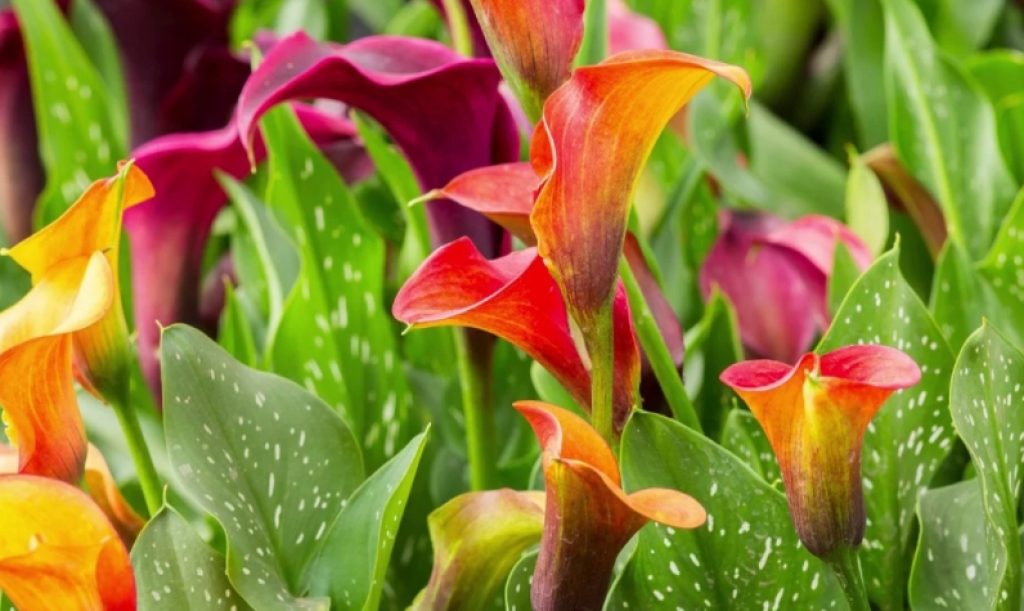The white, red, salmon, pink, yellow to pale yellow, orange, apricot, and the banana-like, tropical-looking, large leaves make calla lilies very alluring ornamental and houseplants. Are they safe for cats or toxic?
Calla lilies or arum lilies (Zantedeschia aethiopica) is a plant species in Araceae native to Swaziland, Lesotho, and South Africa. While the name may suggest otherwise, this perennial, herbaceous evergreen flowering plant that grows from rhizomes isn’t a true lily as it doesn’t belong to the lily family, Liliaceae.

Calla lilies are known by other names that include Richardia africana, garden calla, pig lily, florist’s call, Arum lily, white arum, trumpet lily.
However, calla lilies may refer to her species of genus Zantedeschia, i.e., Z. elliottiana and Z. rehmannii, and Z. aethiopica, known as arum lily.
Are they toxic?
While they are quite appealing and showy, calla lilies are toxic or poisonous to cats and even dogs. All parts of the calla lilies plant (leaves, flowers, or stems) and the cultivars like Green Goddess, Crowborough Pink Mist, Red Desire, and White sail are all poisonous to your feline pal.
Calla lilies are toxic and dangerous because they have insoluble calcium oxalates, which are contained in idioblasts cells. When your cat eats calla lilies, their saliva will make the idioblasts burst, shooting out the microscopic insoluble calcium oxalate which will pierce and penetrate the oral and gastrointestinal walls.
Other plants that have insoluble calcium oxalates you need to be worry of include the following:
- Arrowheads
- Peace lily
- Philodendrons
- Pathos
- Umbrella plant
- Elephant’s ear
- Chinese evergreen (schefflera)
- Dumbcane
- Dieffenbachia
Note that plants such as star-fruits, begonias, rhubarb, and shamrock have soluble calcium oxalates as their toxicity mechanism is different.
Symptoms of toxicity
Some of the commonly noted toxicity symptoms of calla lilies include the following:
- Drooling
- Vomiting
- Swallowing difficulties
- Severe irritation and burning sensation in the mouth, lips, tongue, throat, and gastrointestinal tract.
- Refusal to eat
- Mouth pawing
- Breathing difficulties (infrequent)
If you suspect your cat ate calla lilies or shows any of the above symptoms, don’t try anything at home. Instead, call any animal pet poison helpline or take your kitty to your vet. If possible, carry the suspected plant in a sealed plastic bag.
Protection
Now that calla lilies are not safe for cats or even dogs, the best way to protect this pet is not to have these houseplants or garden and poolside ornamentals. Why not go for African violets, spider plants, Calathea, polka dot plant, orchid, parlor palms, lace flower vines, Christmas cactus, air plants, and many others that are safe to your cat and dog?
If switching to these plants isn’t a favorable choice, we would like to recommend ways to ensure you don’t risk your cat’s health, such as:
- Invest in a plant terrarium that limits access to these plants. A glass one will be ideal since it will still allow you to see your beautiful plant.
- Consider some of the commercial rabbit repellents such as PetSafe SSSCAT Spray Dog and Cat Deterrent that senses your cat’s motion and activates.
- If you have them outdoors, there are repellents and deterrents suited for outside. Why not try Llfaiww. However, we feel that Orbit will do the job better.
Besides these techniques, ensure you pick any leaves or petals that fall or those from cut flowers, train your cat not to eat plants. Also, give them alternative safe cat grass and greeneries to eat and keep them engaged as boredom tends to encourage them to graze more or eat non-food material.
Other harmful plants
Besides the story of calla lilies, which are toxic to your felines, there are many other plants you need to worry about if you have them in your home, like:
- Amaryllis
- Chrysanthemum
- Azaleas
- Daffodils
- Aloe vera
- English ivy
- Monstera Deliciosa
- Tulips
- Pothos
- Snake plants
- Jade plants
- Sago palm
- Poinsettias
- Cyclamen
- Jade plants
- Mistletoe
- Peace lily
- Holly
- Begonia
- Oleander
We didn’t give you a definitive list but rather the common ones that you are likely to mistake as safe for your pets.
